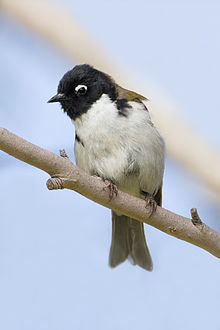- Black-headed Honeyeater
-
Black-headed Honeyeater 
Conservation status Scientific classification Kingdom: Animalia Phylum: Chordata Class: Aves Order: Passeriformes Family: Meliphagidae Genus: Melithreptus Species: M. affinis Binomial name Melithreptus affinis
(Lesson, 1839)The Black-headed Honeyeater (Melithreptus affinis) is a species of bird in the Meliphagidae family. It is one of two members of the genus Melithreptus endemic to Tasmania. Its natural habitats are temperate forests and Mediterranean-type shrubby vegetation.
Contents
Taxonomy
The Black-headed Honeyeater was described in 1839 as Eidopsarus affinis. John Gould described it as Melithreptus melanocephalus in 1844, likely unaware of its earlier name.[1]
Molecular studies show the Black-headed Honeyeater is most closely related to the White-naped Honeyeater, and that their next closest relative is the Western White-naped Honeyeater. All are members of the genus Melithreptus with several species, of similar size and (apart from the Brown-headed Honeyeater) black-headed appearance, in the honeyeater family Meliphagidae. The next closest relative outside the genus is the much larger but similarly marked Blue-faced Honeyeater.[2] More recently, DNA analysis has shown honeyeaters to be related to the Pardalotidae (pardalotes), Acanthizidae (Australian warblers, scrubwrens, thornbills, etc.), and the Maluridae (Australian fairy-wrens) in a large Meliphagoidea superfamily.[3]
Description
A mid-sized honeyeater, it is olive green above and white below, with a wholly black head that lacks the white nape of its relatives. It has a blue-white patch of bare skin around the eye. Its beak is small.
Distribution and habitat
The Black-headed Honeyeater is endemic to Tasmania, where it is found in wet and dry sclerophyll forests, as well as scub and heathland, and subalpine habitats to an altitude of 1200 m (4000 ft).
Feeding
Insects form the bulk of the diet, and the Black-headed Honeyeater specialises in foraging among the foliage of trees, as opposed to probing the trunk for prey which is practised by its relative the Strong-billed Honeyeater, and the two species rarely overlap.[4] Birds often hang upside down from branches while foraging.
References
- ^ Campbell, AG (1938). "John Gould Amongst Tasmanian Birds". Emu 38 (3): 138–41. doi:10.1071/MU938138.
- ^ Driskell, A.C., Christidis, L (2004) Phylogeny and evolution of the Australo-Papuan honeyeaters (Passeriformes, Meliphagidae) Molecular Phylogenetics and Evolution 31 943–960
- ^ Barker, F.K., Cibois, A., Schikler, P., Feinstein, J., and Cracraft, J (2004) Phylogeny and diversification of the largest avian radiation. Proceedings Natl. Acad. Sci., USA 101 11040-11045
- ^ Slater, Peter J. (1994). "Niche Overlap Between Three Sympatric Short-billed Honeyeaters in Tasmania". Emu 94 (3): 186–192. doi:10.1071/MU9940186.
- BirdLife International 2004. Melithreptus affinis. 2006 IUCN Red List of Threatened Species. Downloaded on 26 July 2007.
Categories:- IUCN Red List least concern species
- Melithreptus
- Birds of Australia
- Tasmanian restricted-range endemic bird species
- Animals described in 1839
Wikimedia Foundation. 2010.

